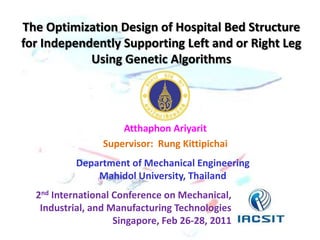
T00107
- 1. The Optimization Design of Hospital Bed Structure for Independently Supporting Left and or Right Leg Using Genetic Algorithms Atthaphon Ariyarit Supervisor: Rung Kittipichai Department of Mechanical Engineering Mahidol University, Thailand 2nd International Conference on Mechanical, Industrial, and Manufacturing Technologies Singapore, Feb 26-28, 2011
- 2. Content • • • • • • • • • Introduction Objective Related Works Hospital Bed Structure Finite Element Analysis Genetic Algorithms Optimization Problem Result and Discussion Conclusion MIMT 2011, Singapore, Feb 26-28, 2011 2
- 3. Introduction • Many types of the hospital bed • Lift the head and/or leg section of bed MIMT 2011, Singapore, Feb 26-28, 2011 3
- 4. Causes & Problems • Structure of the hospital bed is typically complicate and heavy • Hard to move because of heavy weight • Bed cannot support independently either left or right broken-leg • Today, either left or right leg side of bed structure can be lifted MIMT 2011, Singapore, Feb 26-28, 2011 4
- 5. Objective • Design the hospital bed structure for supporting left and/or right Leg • Minimize structural mass of a base of bed subject to structural constraints MIMT 2011, Singapore, Feb 26-28, 2011 5
- 6. Related Works • Jenkins (1997) Multistory frame with truss-supported hangers for optimization study MIMT 2011, Singapore, Feb 26-28, 2011 6
- 7. Related Works • Annicchaiarico and Cerrolaza (1998) • Coello and Christiansen (2000) • Deb and Gulati (2001) 25-bar truss tower MIMT 2011, Singapore, Feb 26-28, 2011 7
- 8. Hospital Bed Structure • Size of bed structure: width x length is 0.8 x 2 m • Analyze only a base of bed structure MIMT 2011, Singapore, Feb 26-28, 2011 8
- 9. Hospital Bed Structure • Material of structure is Steel Alloy 4140 • Down and side force were assumed as distributed force MIMT 2011, Singapore, Feb 26-28, 2011 9
- 10. Finite Element Analysis FEA is applied to bed structure to find Structural deformation, stress and buckling MIMT 2011, Singapore, Feb 26-28, 2011 10
- 11. Genetic Algorithms • GAs is an optimization method • GAs is a stochastic search method based on the theory of natural selection • GAs is an unconstrained optimization method • Technique of penalty function is used to solve constrained optimization problem MIMT 2011, Singapore, Feb 26-28, 2011 11
- 12. Genetic Algorithms • The search procedure start with an initial population as parents • Initial population of individual is randomly created • Real-number design parameters is in binary string • Genetic operator are applied to the parent to create offspring • Probability of a gene used for breeding in terms of fitness • Procedure is repeated until an optimum is achieved MIMT 2011, Singapore, Feb 26-28, 2011
- 13. Operator of Genetic Algorithm • Selection • Crossover – Parent1 = – Parent2 = – Offspring1 = – Offspring2 = 1010|1101 1100|1010 1010|1010 1100|1101 • Mutation – Parent = – Offspring = 1001001 1011000 MIMT 2011, Singapore, Feb 26-28, 2011 13
- 14. Genetic Algorithms MIMT 2011, Singapore, Feb 26-28, 2011 14
- 15. Optimization Problem • • • • • • • • GAs parameter Each design variable contained 10 binary bits The number of population in each generation was 500 The number of generation was set to 1500 The probability of crossover on each generation was 0.8 The probability of mutation on each generation was 0.2 Bound Constraints Search limits of the width and height in each cross-section area of the element was defined between 1 to 5 cm • Displacement Constraints • Displacement of structure is allowed <= 1 cm MIMT 2011, Singapore, Feb 26-28, 2011 15
- 16. Optimization Problem The optimization problem can be written as Minimize f(x) = the mass of 54-beam structure Subject to 1 – Ri 0; i = 1, …, 54 λi – 1 0; i = 1, …, 54 ν - (1 - 0 .0 1 ) 0; j = 1, …, 34 and 0.01 xk 0.05; k = 1, 2, …, 108 • All are done in MATLAB with developing FE code j MIMT 2011, Singapore, Feb 26-28, 2011 16
- 17. Result of Optimization Problem
- 18. Result of the best fitness on each generation 49.25 kg
- 19. Results at Minimum Mass Element No. 1,6 2,7 3,5 4 8,9 10 11,16 12,15 13,14 17,42 18,41 19,40 20,39 21,38 Width 0.0296 0.0210 0.0101 0.0141 0.0120 0.0132 0.0256 0.0182 0.0156 0.0292 0.0102 0.0268 0.0403 0.0150 Height 0.0170 0.0126 0.0267 0.0110 0.0258 0.0150 0.0116 0.0175 0.0231 0.0157 0.0288 0.0101 0.0114 0.0382 Element No. 22,37 23,36 24,43 25,48 26,47 27,46 28,45 29,44 30,50 31,49 32,51 33,53 34,52 35,54 MIMT 2011, Singapore, Feb 26-28, 2011 Width 0.0222 0.0108 0.0140 0.0278 0.0279 0.0125 0.0152 0.0202 0.0165 0.0140 0.0171 0.0107 0.0102 0.0108 Height 0.0460 0.0288 0.0110 0.0167 0.0203 0.0209 0.0376 0.0218 0.0100 0.0180 0.0143 0.0179 0.0211 0.0237 19
- 20. Result and Discussion MIMT 2011, Singapore, Feb 26-28, 2011 20
- 21. Conclusion • Mass of bed structure was successfully minimized • Size of cress-section area in each beam was reduced • Displacement of each node or structure was accepted • Stress in each element was accepted • Therefore, it is possible to design the hospital bed for independently supporting left and or right leg using GAs including FEA MIMT 2011, Singapore, Feb 26-28, 2011 21
- 22. Conclusion MIMT 2011, Singapore, Feb 26-28, 2011 22
- 23. Thank you very much for your attention MIMT 2011, Singapore, Feb 26-28, 2011
- 24. MIMT 2011, Singapore, Feb 26-28, 2011
